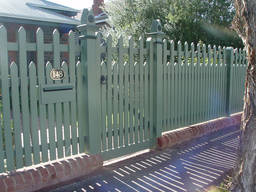How to choose the best fencing for your home
First and foremost is choosing the right style of fencing to compliment the style and architecture of your home. For example a traditional home may suit a picket fence or perhaps a sandstone wall. While a contemporary home could suit anything from timber or steel to a brick, rendered or stone wall.
As always it’s advisable to do your research. Take photos of fences that appeal to you. Collect pictures from home and garden magazines. Search the internet for ideas or speak to your architect or landscape designer.
If it is the front fence of your home that is being built, it should be a perfect fit for the lay of the land, the size of the boundary as well as the architecture of your home. The front of your home creates a first impression and always leaves a lasting impression. The gardens, their maintenance and the front fence are a very important part of those impressions.

As long as your front fence complies with council regulations you can please yourself as to what you choose. However, boundary fences that you share with neighbours need to be discussed with the relevant neighbour and agreed upon. In most cases the cost is shared and access for construction is usually required through both properties. Many neighbourhood disputes have arisen from fencing issues, so you may need to compromise on matters such as choice of materials, height and costs. If the end result is really not to your liking you can always grow a vine over it. A better solution than ending up in court!
Other factors you may need consider are security, height, privacy, light and noise reduction. Is the fence purely for aesthetics? Do you need to keep your children and pets in and the neighbours dogs out? Do you need to include automatic gates? Do you need to block out your neighbours unsightly yard? Or their prying eyes? Do you need a secure and compliant pool fence? Or a wire fence for your chooks, aviary or vegie garden? Do you want to disguise the pool filter and equipment, the garden shed, or washing line? Once the needs and purpose of the fence are established it’s time to get some quotes.
Fencing materials include timber, steel, aluminium, bamboo, brushwood, glass as well as brick, rendered or stone walls and any combination of these products. There is also a range of panel fencing such as Colorbond, PVC or vinyl which are maintenance free so will never require painting and they won’t rot or rust. A fencing professional will assess the area to be fenced and ascertain if a retaining wall is required He will also be able to help you with the right choice to suit your needs and budget. Check if your fencing contractor will demolish and remove the old fencing and clear the fencing line. If you are unsure of council regulations it’s always best to check in case approval is required.
A new fence can initially look a bit harsh but that can easily be transformed with the addition of some plants to soften the appearance. A new fence will not only complete the look of your property, it can create safety, privacy and street appeal, while adding value to your biggest asset.
To find the best fencing contractor or fencing supplier in your area, search our home improvement directory.
Quick Links
- Fencing Contractors & Services in Australia
- Fencing Contractors & Services in Adelaide
- Fencing Contractors & Services in Brisbane
- Fencing Contractors & Services in Inner North
- Fencing Contractors & Services in Hobart & South East
- Fencing Contractors & Services in Melbourne
- Fencing Contractors & Services in Darwin
- Fencing Contractors & Services in Sydney
- Fencing Contractors & Services in Perth

